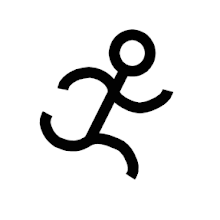Next week is my last week of marathon training ... and Boston is months away! After that, I'm switching to Coach Norrie's Comrade marathon program, which should prepare me for the Sulphur Springs 50 miler. My mileage should quickly go from about 70 km per week to about 90 km.
In my book, that's a lot of mileage and thankfully, the speed workouts are not as intense although there are a few tempo runs that look nasty.
I've been hovering around the 70k mark for over a month now and mt body seems to be holding out. The only part of my body that hurts a bit is my right foot, above my heel. It's not getting worse, and maybe improving a bit but it's there.
In the last couple of weeks, I've done a lot of trail running in the deep snow. On the one hand, it's really nice but it's also harder. I don't think I could do it in regular running shoes, but my new La Sportive Crosslite Trail shoes make it fun.
I'm pretty happy with my training. I've skipped a couple of speed session but I feel much faster than before Xmas. Treadmill work, as much as I hate to admit it, has a way of keeping you honest when doing intervals or hills. I don't really feel like racing right now because the conditions are just too nasty. Deep snow and ice everywhere. Sure fire way of getting hurt and I don't need that. I might go for my 5k PR at the St-Patrick's race. That's where I set my current, official PR although I ran much faster at the Resolution run but the course was a bit short.
For the first time in a long time, I don't resent Winter. I'm even re-discovering it a bit with my trail running. I'm thinking of trying snow shoe racing. A bit hard to train around here though, but it might still be fun to try it. I'm thinking of renting a pair of snow shoes at the MEC next week and give it a try.
I still haven't got on the bike. I don't have an excuse, I just didn't do it.
I'm so into running now that I'm kind of wondering how I will get back into triathlon-mode. I'm sure when the nice weather comes back the decision won't be hard to make.
I love running, but I don't want to be a one trick pony who is devastated when injured. By doing multi-sports, it's easier to prevent injuries by shifting training around the 3 sports. If your legs hurt, you can just go for a swim, you don't feel like your only option is running. I believe that I will run for longer if I also enjoy other sports.


